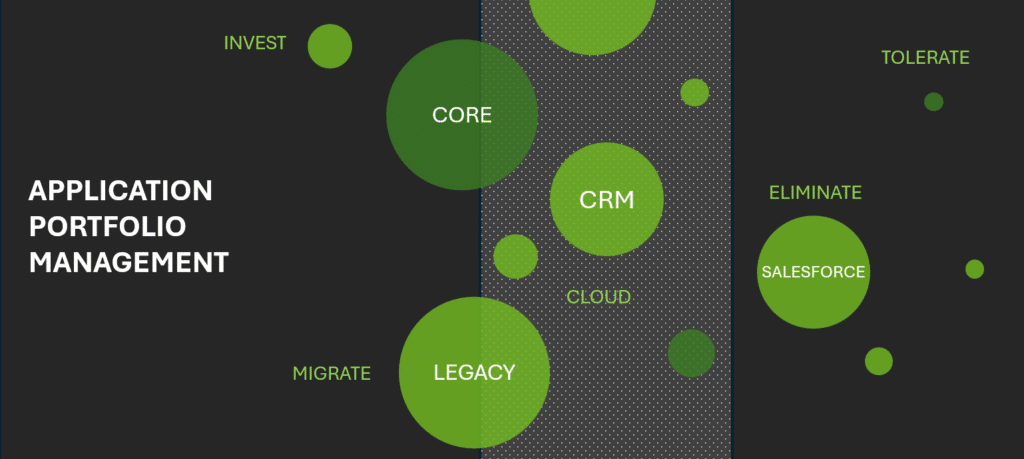
Organizations are increasingly dependent on a myriad of software applications to drive their operations and achieve strategic goals. However, managing these applications effectively can be a daunting task, especially as portfolios grow in size and complexity. This is where Application Portfolio Management (APM) comes into play.
But what exactly is APM, and why should your organization consider adopting it?
What is Application Portfolio Management (APM)?
Application Portfolio Management (APM) is a systematic approach to managing and optimizing an organization’s software applications and their respective value to the business. APM involves cataloging applications, assessing their performance and value, and making informed decisions about their future—whether to maintain, upgrade, replace, or retire them.
Essentially, APM provides a holistic view of the application landscape, enabling better alignment with business objectives and efficient use of resources.

Why is Application Portfolio Management Important?
Let’s take a look at some reasons that application portfolio management matters to an enterprise.
1. It Enhances Strategic Alignment
APM ensures that all applications support the organization’s strategic goals and initiatives. By continuously evaluating the relevance and performance of applications, businesses can ensure that their software investments are aligned with their strategic direction.
2. It Optimizes Costs
Through APM, organizations can identify redundant, outdated, or underperforming applications that consume resources without delivering adequate value. This enables cost reduction by consolidating or eliminating such applications, thereby optimizing the IT budget.
3. It Improves Operational Efficiency
Effective APM helps streamline processes and reduces the complexity of the IT environment. By managing the application lifecycle more efficiently, organizations can enhance productivity, reduce downtime, and improve overall operational efficiency.
4. It Mitigates Risks
APM helps identify and address potential risks associated with software applications, such as security vulnerabilities, compliance issues, and obsolescence. Proactive risk management ensures the stability and security of the IT environment.
Key Components of Application Portfolio Management
Having looked at why you need APM, let’s examine some of its most important facets.
1. Application Inventory
The first step in APM is creating a comprehensive inventory of all applications within the organization. This inventory includes details such as application name, version, vendor, usage, and associated business processes.
2. Application Assessment
Assessing the performance, cost, and business value of each application is crucial. This involves evaluating factors such as user satisfaction, technical health, maintenance costs, and alignment with business objectives.
3. Application Rationalization
Based on the assessment, applications are categorized into different groups, such as strategic, tactical, and redundant. Rationalization involves making decisions on whether to retain, upgrade, consolidate, or retire applications based on their categorization.
4. Software Asset Management Best Practices
Incorporating software asset management (SAM) best practices into APM can enhance the efficiency of managing software licenses and compliance. SAM involves tracking software usage, ensuring compliance with licensing agreements, and optimizing software spend.
5. Business Capability Model
A business capability model provides a structured way to assess how applications support key business capabilities. Aligning applications with the business capability model helps ensure that IT investments are driving the desired business outcomes.
6. License Optimization
Optimizing software licenses is a crucial aspect of APM. License optimization ensures that the organization is not overspending on software licenses and that it is fully compliant with vendor agreements. This can involve re-negotiating contracts, consolidating licenses, and eliminating unused licenses.
7. Governance and Policy
Establishing governance frameworks and policies is essential for effective APM. This includes defining roles and responsibilities, setting standards for application management, and ensuring compliance with regulatory requirements.
8. Continuous Improvement
APM is an ongoing process that requires continuous monitoring and improvement. Regular reviews and updates to the application portfolio ensure that it remains aligned with the evolving needs of the organization.

How to Get Started with Application Portfolio Management
If you’re sold on the concept of APM, you might be wondering how to implement it. Let’s take a look.
Step 1: Gain Executive Support
Successful APM initiatives require buy-in from top management. Highlight the strategic benefits and potential cost savings to secure executive support and necessary resources.
Step 2: Assemble a Cross-Functional Team
Form a team comprising members from IT, finance, and business units. A cross-functional team ensures diverse perspectives and comprehensive analysis during the APM process.
Step 3: Develop a Detailed Application Inventory
Create a detailed inventory of all applications, including their usage, costs, and associated business processes. This inventory forms the foundation for all subsequent APM activities.
Step 4: Conduct a Thorough Assessment
Evaluate each application based on criteria such as performance, cost, business value, and alignment with strategic goals. Use this assessment to categorize applications and identify opportunities for rationalization.
Step 5: Implement Governance Frameworks
Establish governance policies and frameworks to guide the APM process. Define roles, responsibilities, and standards for application management and ensure compliance with these policies.
Step 6: Execute the Rationalization Plan
Based on the assessment and categorization, make informed decisions about the future of each application. Execute plans to retain, upgrade, consolidate, or retire applications as appropriate.
Step 7: Monitor and Improve Continuously
APM is a dynamic process that requires ongoing monitoring and improvement. Regularly review and update the application portfolio to ensure it remains aligned with business objectives and adapts to changing needs.
Challenges in Implementing Application Portfolio Management
And, finally, it’s worth considering some friction that you might face as you adopt APM.
1. Resistance to Change
Employees may resist changes to familiar applications and processes. Effective communication and change management strategies are essential to address resistance and ensure smooth implementation.
2. Data Quality and Completeness
Accurate and complete data is critical for effective APM. Ensuring high-quality data collection and maintenance can be challenging but is necessary for reliable decision-making.
3. Resource Constraints
Implementing APM requires significant time and resources. Balancing APM activities with other organizational priorities can be difficult, especially in resource-constrained environments.
4. Ensuring Continuous Improvement
Maintaining the momentum of continuous improvement in APM can be challenging. Establishing regular review cycles and fostering a culture of continuous improvement is vital for sustained success.
5. The Role of IT Audits in APM
IT audits play a crucial role in the APM process by providing an independent assessment of the organization’s IT assets. Regular IT audits help ensure compliance with policies, identify areas for improvement, and verify the accuracy of the application inventory. Incorporating IT audits into the APM strategy can enhance transparency, accountability, and overall effectiveness.

Conclusion
Application Portfolio Management is a powerful tool for organizations looking to optimize their software investments, align IT with business goals, and improve operational efficiency. By understanding what APM is, recognizing its benefits, and following a structured approach to implementation, organizations can unlock significant value and drive strategic success.
As technology continues to evolve, APM will remain a crucial component of effective IT management, ensuring that application portfolios are well-managed, cost-effective, and aligned with organizational objectives.

